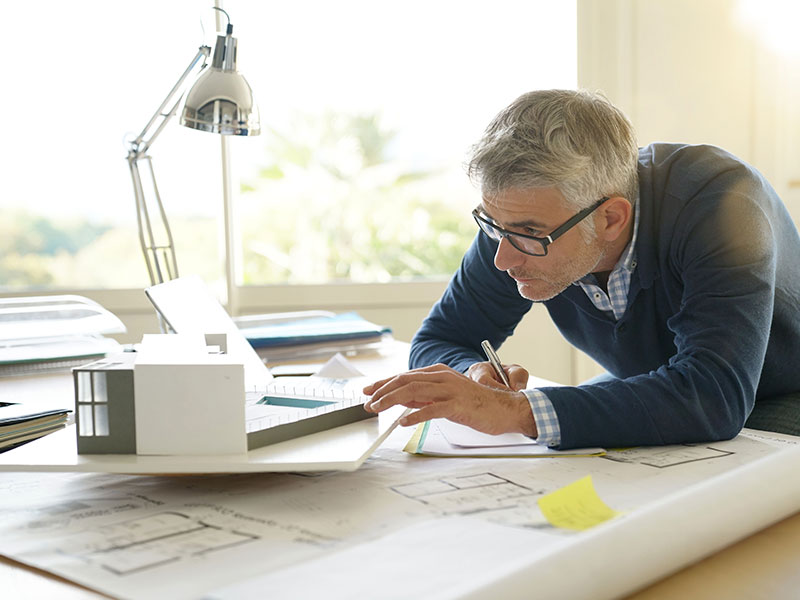Architect Workflow Optimization for Faster Project Delivery
Architect Workflow Optimization for Faster Project Delivery
Blog Article
Comprehending the Diverse Job Paths Available for Aspiring Architect
As an ambitious Architect, you have a globe of career paths awaiting you. Each path uses unique obstacles and opportunities to use your imagination and technical expertise. Whether you're drawn to typical design or the subtleties of sustainable style, there's a niche that lines up with your passions. Understanding these diverse alternatives can shape your specialist journey, yet which instructions will you select to explore first?
Typical Architecture: Designing Frameworks and structures
Traditional architecture concentrates on making structures and frameworks that blend capability with visual allure. Your styles can show cultural heritage, showcasing local traditions while fulfilling modern-day demands.
You'll establish skills in drafting, model-making, and site evaluation, enabling you to picture and communicate your ideas effectively. Involving with customers, you'll need to understand their vision and convert it right into possible styles.
Furthermore, constructing codes and sustainability techniques are necessary in your work, ensuring your frameworks are risk-free and environmentally friendly. As you expand in your profession, you'll locate possibilities in property, commercial, and even remediation projects, each offering one-of-a-kind difficulties. Embracing typical design leads the way for a fulfilling career that admires the past while forming the future.
Urban Planning: Forming Neighborhoods and Public Spaces
As an aspiring Architect, you can play a vital role as a metropolitan planner, changing how areas work and interact. By utilizing community interaction strategies, you'll assure that locals have a voice fit their environment. And also, incorporating sustainable design concepts will certainly assist create areas that not just meet today's demands but likewise protect the future.
Function of Urban Planners
While lots of could consider architects as the sole visionaries behind buildings, metropolitan organizers play an important role in forming the wider landscape of communities and public spaces. They assess land use, zoning legislations, and area requires to create sustainable atmospheres that improve top quality of life. By collaborating with various stakeholders, you'll assist make parks, transport systems, and houses that promote social interaction and access. Urban planners also concentrate on environmental considerations, ensuring that advancements integrate eco-friendly areas and assistance biodiversity. Your proficiency in spatial design and community dynamics allows you to envision future development while maintaining social heritage. In this crucial role, you'll straight affect just how individuals experience their surroundings, making every job a chance for positive change.
Neighborhood Engagement Approaches
Reliable community involvement methods are important for city coordinators to guarantee that the voices of homeowners are heard and valued in the preparation procedure. To foster purposeful dialogue, you need to focus on open forums and workshops where area participants can express their concepts and worries. Use surveys and social networks to get to a broader audience, making sure diverse point of views are consisted of. Collaborating with neighborhood organizations can enhance trust and promote deeper connections. It is very important to give clear information about decision-making procedures and proposed projects, permitting residents to feel informed and equipped. By actively listening and including feedback, you'll develop spaces that show the area's needs, eventually resulting in even more effective and lasting urban atmospheres. Welcome openness and continual dialogue for long lasting effect.
Sustainable Design Concepts
When making city rooms, including lasting style principles is crucial for creating environments that flourish both ecologically and socially. You should begin by focusing on power performance, using materials that minimize waste and advertise recycling. Consider incorporating eco-friendly areas, like parks and gardens, to improve biodiversity and enhance air top quality. Advertising walkability and public transportation can reduce dependence on automobiles, promoting a much healthier neighborhood.
Designing with water conservation in mind is additionally crucial-- think of rain yards and permeable surface areas to manage stormwater. Entailing community members throughout the planning procedure guarantees that the areas you develop satisfy their requirements and urge social communication. By accepting these principles, you'll add to dynamic, sustainable city landscapes that benefit every person.

Landscape Style: Developing Sustainable Exterior Atmospheres
As you explore landscape design, you'll find essential design concepts that develop practical and stunning outdoor areas. Sustainable techniques play an essential role in making certain these atmospheres thrive while decreasing ecological effect. Plus, you'll locate a variety of job chances that enable you to make a genuine difference in exactly how individuals communicate with nature.
Layout Concepts in Landscape
Comprehending style principles in landscape architecture is crucial for developing sustainable outdoor environments that balance with nature. You'll need to consider components like proportion, equilibrium, and range to ensure your layouts feel cohesive and welcoming. Integrating indigenous plants not only enhances biodiversity but also reduces water usage, making your landscape resilient. Consider the flow of area and just how people engage with it; pathways and seating areas must welcome exploration and relaxation. In addition, take note of seasonal modifications, designing with products that complement the surroundings year-round (Architect). By focusing on sustainability and aesthetics, you can create exterior spaces that enhance the community and promote wellness. Welcoming these concepts will certainly set a strong structure for your profession in landscape architecture.
Sustainable Practices Summary
Sustainable practices in landscape architecture not just concentrate on aesthetics but additionally prioritize ecological health and source preservation. By incorporating native plants, you enhance biodiversity and lower the demand for chemical plant foods and chemicals. Implementing efficient visit site irrigation systems assists save water and minimizes runoff, protecting close-by communities. You can develop rooms that advertise soil wellness, such as practicing and using organic products permaculture principles. Additionally, incorporating eco-friendly framework, like rainfall yards and porous pavements, help in stormwater management and decreases metropolitan warm. When you produce exterior environments with sustainability in mind, you add to a healthier planet and supply spaces that promote area link. Inevitably, these practices ensure your layouts profit both individuals and the setting for years to find.
Occupation Opportunities Expedition
With a solid structure in sustainable techniques, landscape architecture supplies a variety of career courses that permit you to make a purposeful effect on the environment. Urban coordinators typically team up with landscape architects to produce environment-friendly spaces in city settings, boosting city livability. If you're passionate about education and learning, consider ending up being a landscape style educator, inspiring future generations.
Lasting Style: Concentrating on Eco-Friendly Practices
As you discover your occupation in architecture, welcoming environment-friendly methods can establish you apart in a competitive field. Lasting design concentrates on producing buildings that decrease ecological impact while enhancing resident wellness. By incorporating renewable products, energy-efficient systems, and lasting building methods, you'll contribute to a greener future.
Beginning by getting understanding of eco-friendly certifications like LEED or BREEAM, which can strengthen your qualifications. Think about exactly how natural light, air flow, and thermal efficiency can enhance layout. Collaborate with designers and ecological specialists to innovate options that reduce waste and conserve resources.
Do not fail to remember the significance of area involvement-- interesting neighborhood stakeholders can motivate designs that harmonize with the atmosphere. As clients progressively focus on sustainability, your knowledge in environment-friendly techniques will certainly not just bring in jobs but likewise accomplish your interest for accountable design. Embrace this crucial aspect of the occupation, and enjoy your profession grow.
Historic Preservation: Safeguarding and Bring Back Cultural Heritage
While you start on your building trip, think about the vital function of historic preservation in keeping our social heritage. This field concentrates on the protection and restoration of significant buildings, sites, and structures that inform the tales of our past. By involving in historical conservation, you'll help guard the architectural heritage that shapes area identification.
As a historical preservation Architect, you'll examine historic significance and analyze the problem of structures. You'll work carefully with preservationists and historians to assure genuine reconstruction methods are employed. This occupation path enables you to mix imagination with study, enabling you to design services that respect original materials and craftsmanship.
Your work not just adds to sustainability by recycling existing structures but likewise fosters a sense of satisfaction within communities. Accepting this course will certainly assist you come to be a guardian of history, protecting the tales and looks that enrich our lives.
Inside Design: Enhancing Indoor Spaces
Historic preservation and interior architecture both share a commitment to boosting the built atmosphere, however they concentrate on various aspects. While historical preservation highlights preserving a framework's historical and cultural value, interior design nos Get More Information in on maximizing interior rooms for functionality and aesthetics.
As an aspiring Architect, you'll discover that interior design permits you to mix creativity with technical skills. You'll develop areas that not only look great yet additionally advertise convenience and efficiency. This field involves understanding how light, color, and materials interact within a space, impacting state of mind and use.
You'll deal with various projects, from property homes to industrial offices, making sure that each setting fulfills the demands of its occupants. By prioritizing user experience, you can transform interiors right into practical and inspiring areas, making a considerable effect on just how people interact with their environments. Accept the chance to enhance interior settings and shape the way people live and function.
Industrial Style: Merging Functionality With Aesthetic Appeals
Industrial design plays an important role in developing items that seamlessly blend appearances with functionality, ensuring that what you use day-to-day is not only aesthetically appealing yet likewise useful. As an ambitious Architect, you could involve yourself in this area, concentrating on making every little thing from furniture to customer electronics. Your job involves recognizing user demands, materials, and making processes, permitting you to create ingenious solutions that boost everyday experiences.
In commercial layout, you'll usually collaborate with makers, engineers, and online marketers, ensuring that your designs are not just beautiful yet additionally practical. This occupation path offers a vibrant setting where imagination meets practicality, making it a fulfilling selection for designers interested in shaping the items of tomorrow.
Regularly Asked Concerns
What Educational Credentials Do I Need to Become an Engineer?
To end up being an architect, you'll need a specialist level in architecture, typically a Bachelor's or Master's. In addition, you'll need to complete a teaching fellowship and pass the Architect Enrollment Exam to exercise legally.
Are There Certification Needs for Different Architectural Job Paths?
Yes, there're qualification demands for various building courses. Architect. You'll require to pass exams, complete teaching fellowships, and occasionally go after specialized training, relying on your selected focus, like landscape architecture, city design, or historic preservation
What Software Abilities Are Important for Engineers Today?

Just How Can I Gain Practical Experience While Examining Architecture?
You can obtain functional experience by interning at architectural companies, taking part in layout competitions, offering for neighborhood projects, or working together with my website classmates on real-world assignments. These opportunities improve your abilities and develop beneficial links in the market.
What Work Opportunities Exist Outside Typical Architecture Firms?
You can discover various task possibilities outside conventional style firms, like metropolitan preparation, interior style, landscape style, construction administration, property development, or even duties in sustainability consulting. Each offers one-of-a-kind challenges and benefits.
Whether you're attracted to traditional design or the nuances of lasting layout, there's a specific niche that straightens with your passions.When developing metropolitan rooms, incorporating sustainable style concepts is crucial for producing atmospheres that grow both environmentally and socially.As you explore landscape architecture, you'll find necessary layout principles that produce beautiful and practical outdoor spaces.Comprehending style principles in landscape design is necessary for producing sustainable exterior atmospheres that balance with nature.In industrial layout, you'll typically collaborate with makers, engineers, and online marketers, ensuring that your designs are not only attractive but also practical.
Report this page